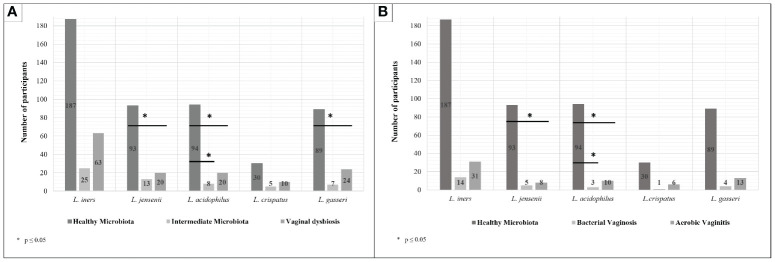Figure 1.
Prevalence of each Lactobacillus species according to the type of vaginal microbiota. (A) Lactobacilli prevalence in healthy microbiota, intermediate microbiota, and vaginal dysbiosis. (B) Lactobacilli prevalence in healthy microbiota, bacterial vaginosis (BV), and aerobic vaginitis (AV). Chi-square tests were performed among the prevalence of each Lactobacillus species in the presence of healthy microbiota, intermediate microbiota, or vaginal dysbiosis (A) and then BV and aerobic vaginitis (AV) (B). (A) The results show statistically significant differences between healthy and intermediate microbiota in Lactobacillus acidophilus (p = 0.026) and Lactobacillus gasseri (p = 0.020). Meanwhile, statistically significant differences between healthy microbiota and vaginal dysbiosis were shown in presence of Lactobacillus jensenii (p = 0.017) and L. acidophilus (p = 0.015). However, no statistically significant differences were established between intermediate microbiota and vaginal dysbiosis. (B) The results show statistically significant differences between healthy microbiota and AV in L. jensenii (p = 0.012) and L. acidophilus (p = 0.045). Meanwhile, only statistically significant differences between healthy microbiota and BV were shown in presence of L. acidophilus (p = 0.041); no statistically significant differences were established between AV and BV.

